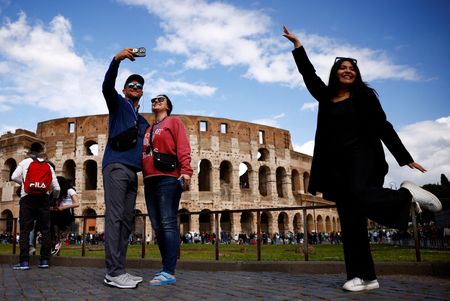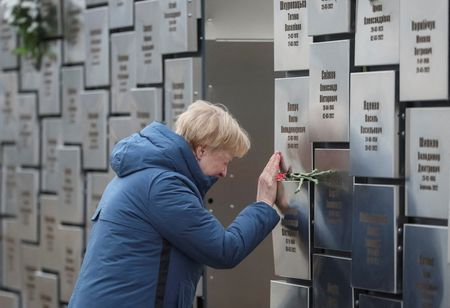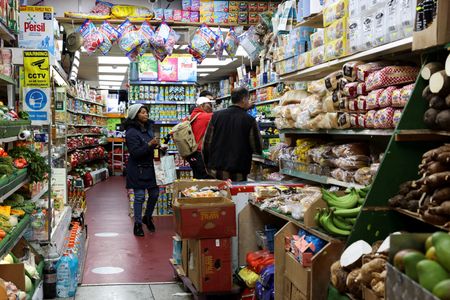By Valentina Za, Francesca Piscioneri and Giulia Segreti
ROME (Reuters) – Having made property investments in Milan, Italian architect Giuseppe Pezzano is now looking for a place in Rome to set up a second home and studio, as the Italian capital’s underdeveloped real estate sector draws fresh attention.
Pezzano’s property hunt highlights a wider shift that has put Rome in the sights of professional real estate investors, after the Milan area took more than half of their investments in Italy in the past five years, based on data by Scenari Immobiliari think-tank.
Now sky-high prices and judicial probes into the fast-tracking of building permits have put a brake on the market in Italy’s financial capital, just as public spending in Rome for the Roman Catholic Holy Year and a friendlier attitude from the local administration draw in investors spotting a bargain.
“In Milan, 400,000 euros ($420,000) gets you an ugly one-bedroom, in Rome you can live in a late 19th-century building,” Pezzano said.
“Rome’s architecture, its open views and its people make it the world’s most beautiful city. I want a window that looks out onto that beauty. And I think I can find new clients there: Rome is on the cusp of an architectural renaissance”.
Rome accounted for 17% of all professional real estate investments last year in Italy, up from an average of 11% over the 2020-2024 period, data by property services firm JLL showed.
Professional property investors poured 1.7 billion euros into Rome projects last year, double the 2023 figure.
The Holy Year, which is forecast to add an extra 10 million tourist arrivals to last year’s 22 million record, has fuelled up to 8 billion euros of public spending to refurbish central areas and strengthen infrastructure.
To promote urban renewal across a city dotted with ancient ruins and some of the world’s most spectacular churches and fountains, Rome in December approved new town planning rules, which it had last updated in 2008.
The city is also striving to narrow the gap with Italy’s more efficient financial capital and ease residents’ daily struggles with public transport, potholed roads and uncollected rubbish.
ROME’S RENAISSANCE
Global real estate investment manager Hines is currently working to secure its first Rome project, after focusing on the north of Italy until now.
“We believe Rome has the potential to experience the real estate renaissance that Milan has undergone over the past decade,” said Hines Italy country head Mario Abbadessa.
The gap between the 12,000-14,000 euros per square metre commanded by an apartment in the centre of Milan, and the 8,000-9,000 euros of an equivalent property in Rome is “excessive”, Abbadessa said. Rome is also cheaper than other southern European capitals like Lisbon or Athens.
The 2015 World Expo ushered in a property boom in Milan with house prices up 27% in 2014-2024 on average, or 52% in semi-central areas, consultancy PwC calculated.
By contrast, Rome’s house prices declined by 14.4% over the past decade, according to think-tank Nomisma.
Investors see value. Rome accounts for the bulk of Czech firm CPI Property Group’s investments in Italy, which have reached 1.5 billion euros from just 53 million in 2018, a person with knowledge of the matter said.
On a smaller scale, Rome projects worth 30 million euros make up over half of Italian group Hera Holding’s property portfolio, up from one fifth in 2018.
‘BUREAUCRACY RISK’
Rome city councillor Maurizio Veloccia acknowledged that Rome has had to restore its credibility with investors.
Many Rome builders, often small, family-owned firms, did not survive the recessions Italy suffered between 2008 and 2013.
“And outsiders were not interested in stepping in because of the ‘bureaucracy risk’,” Veloccia told Reuters.
“Projects stalled half-way, and this reflected badly with public opinion, reinforcing the idea that real estate investments are a danger.”
Marking a shift in attitude, Rome reopened to the public its urban planning department, which had become digital-only during the global pandemic.
To reduce risks and costs for investors faced with lengthy and uncertain approval processes, the administration boosted its decision-making powers.
It also lifted restrictions, such as a cap of 60 rooms for hotels in the city centre, and removed 700 buildings from a list of protected properties that hindered renovation.
“With the Jubilee acting as a catalyst, Rome must now prove it can address the issues that have for so long held back real estate investments,” Scenari Immobiliari Director General Francesca Zirnstein said.
Some stranded construction projects are getting a second lease of life.
One example is the “Ex Fiera di Roma” site, a 76,000-square-metre former convention centre area whose renovation has stalled for 20 years.
A fund backed by banks UniCredit and illimity owns the site, and developer ARECneprix is turning more than half the area into buildings, mostly residential, including a portion of social housing.
Social housing is key to Rome’s efforts to avoid following in Milan’s tracks, where residents are being priced out as wealthy foreigners making use of tax benefits flock in.
Rome’s size is seen as a further defence against gentrification.
“I don’t see Rome becoming a new Milan, it’s too big and full of families and students, not high-flying professionals,” Rome resident Paola Salvetti said.
($1 = 0.9560 euros)
(Reporting by Valentina Za in Milan; Francesca Piscioneri and Giulia Segreti in Rome; Editing by Keith Weir and Frances Kerry)
















